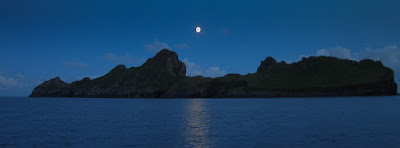On the morning of 14th June, Village Bay, Hirta was a noisy, busy place. First the peace was disturbed by the rumbling diesel of L105 HMAV Arromanches arriving with a load of oil for the power station. Then the interminable Health and Safety reversing beeper of St Kilda's heavy tractor echoed round the hills.
The "beep beep beep" was then joined by a "whup whup whup" as PGD helicopters' G-PDGN (a Eurocopter AS365N Dauphin 2) brought in Qinetiq workers and supplies for the base and prepared to take relieved workers and the mail out.
In comparison our departure was in near silence. The weather was fair but the forecast was for a front to come in from the SW by late afternoon with force 4 to 5 winds and increasing swell.
So we wasted no time and quickly passed the Dun Gap...
...on our way to Seilg Geodha. This cave system goes right through Dun and two days before we had entered from the other side but were unable to get through the slot due to swell from the NE.
This time we got through the slot into the main cavern where we had been before but frustratingly heavy swell, this time from the SW, meant we could not get right through again!
We emerged back into the calm of Village Bay...
...then made our way in increasing swell towards...
...the Great Arch of Dun. This is looking through towards the SW. The photo makes it look as flat as a pancake but this is a huge arch and the scale swamps the size of the swell. This was bouncing back off the right hand wall and breaking over a shallow reef that lies right in the middle of the channel.
With some careful timing...
...the passage through the arch was successfully negotiated....
...and we made our way along the SW coast of Dun.
The swell increased...
...as we approached the Dun Gap. Gordon made the most of the swell wrapping round Cul Cleite. We had now completed our exploration of Dun and were about to experience the exposed SW coast of Hirta!























































